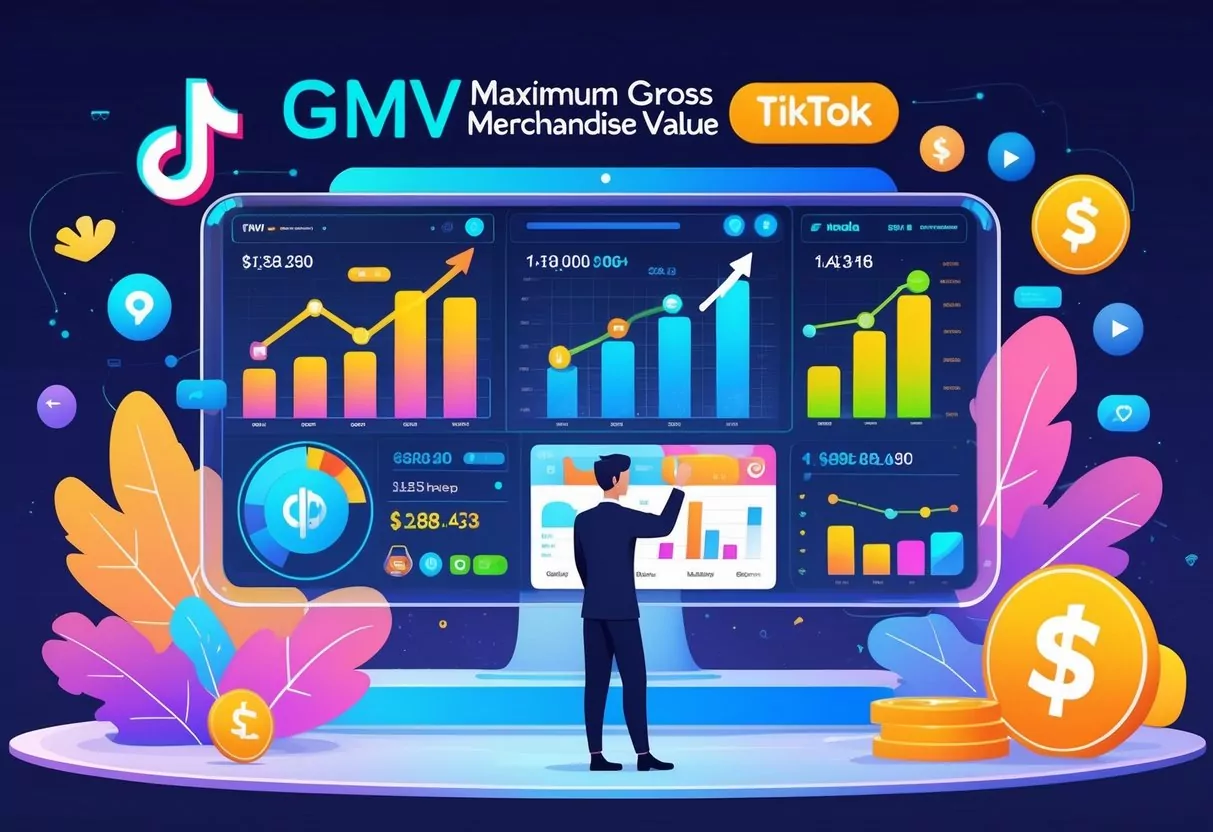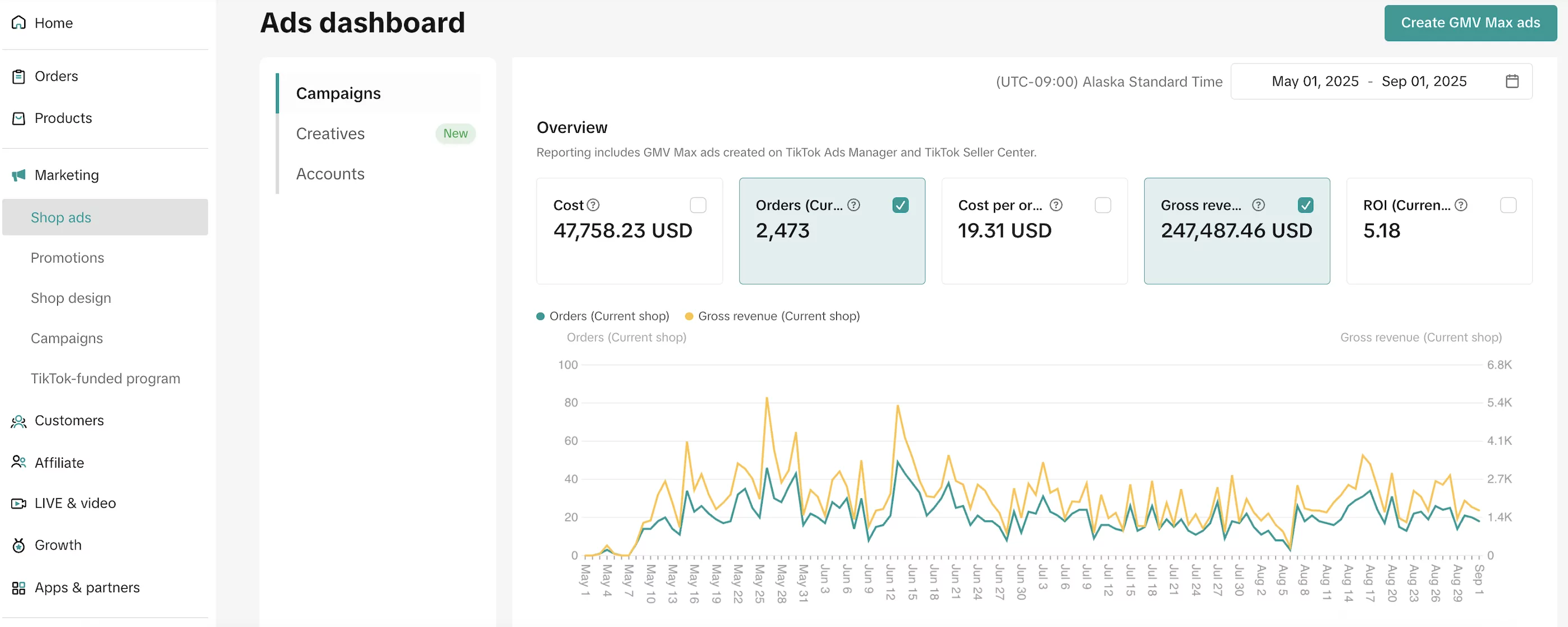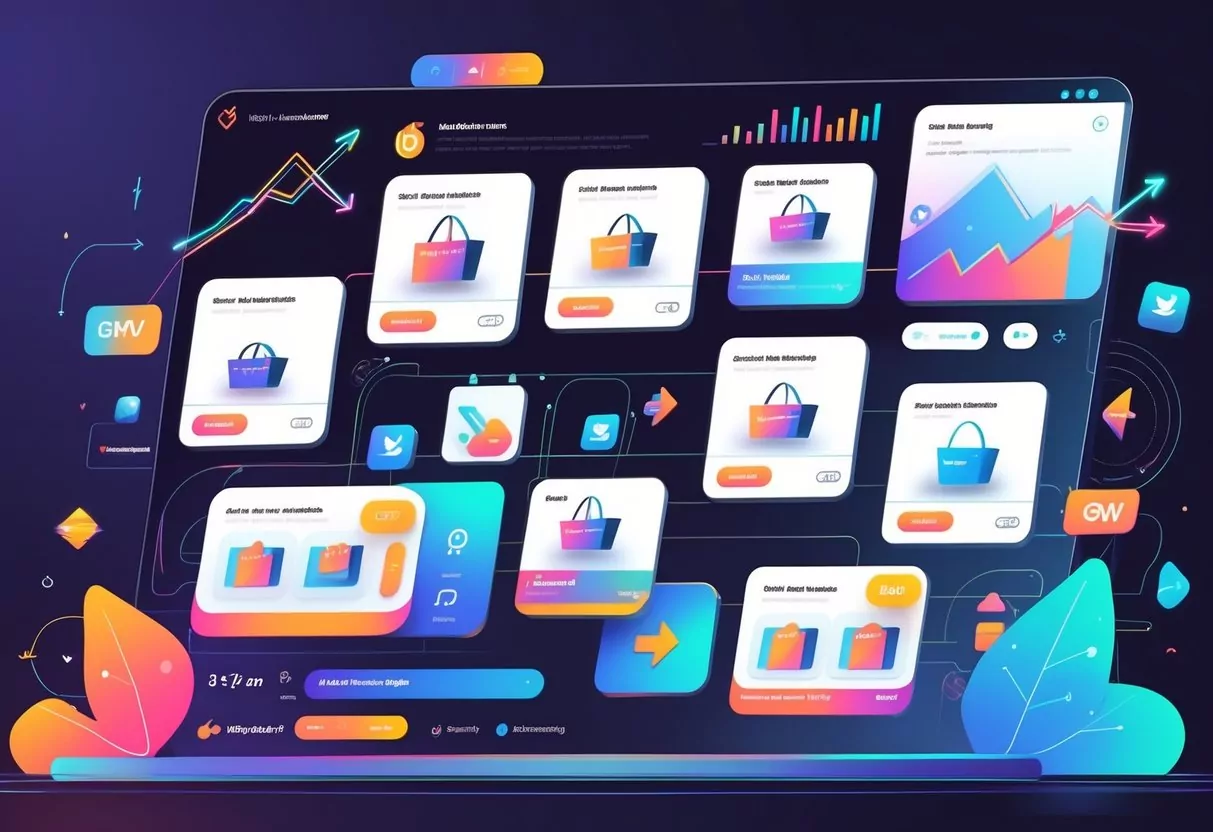If you sell on TikTok Shop, you’ve likely noticed a big shift in how ads work. TikTok now requires GMV Max campaigns for all sellers, replacing older manual ad formats. GMV Max is TikTok’s automated advertising system that optimizes your campaigns to drive the highest possible sales and return on investment across your entire shop.
With GMV Max, you don’t have to guess which products, creatives, or placements perform best. The system uses TikTok’s data to automatically select and adjust these elements in real time. This means you can focus more on your products and less on constant ad management.
As you explore how GMV Max works, you’ll see how it impacts Tiktok campaign setup, creative choices, and performance tracking. You’ll also discover strategies to make the most of this new system and understand what its future means for your business on TikTok Shop.
Learn about top Tiktok Shop Order Issues in this blog and how to resolve those
What Is GMV Max on TikTok?
GMV Max is TikTok’s automated advertising system designed to maximize sales and return on investment for TikTok Shop sellers. It replaces older manual ad formats with a single solution that manages creative assets, campaign optimization, and traffic from both paid and organic sources.
Definition and Core Purpose
GMV Max, also called Product GMV Max, is an automation tool for TikTok Shop Ads. Its main goal is to increase your gross merchandise value (GMV) by combining ad automation with organic reach.
Instead of managing multiple ad types manually, you let GMV Max handle creative selection, placement decisions, and optimization. It uses all available assets—such as videos, product cards, and affiliate content to improve performance.
The system measures ROI across your entire TikTok Shop channel, not just individual campaigns. This means you see the full value of both paid ads and organic traffic linked to your promoted products.
All orders generated through GMV Max campaigns, including affiliate sales, are tracked in your Seller Center dashboard. This gives you a clear view of your product-level performance and revenue impact.
Key Differences from Previous TikTok Shop Ads
Before July 2025, TikTok Shop offered manual ad formats like Live Shopping Ads, Video Shopping Ads, and Shopping Center Ads. These required you to set targeting, placements, and creatives yourself.
With GMV Max, TikTok discontinued those formats and moved to a fully automated system. Instead of creating separate campaigns for each placement, you now run one GMV Max campaign that covers all eligible placements across TikTok Shop.
The platform uses AI to test and scale your best-performing creatives automatically. It also adjusts targeting and bidding in real time to maximize product ROI.
Another difference is compliance. GMV Max automatically applies a commercial content label to affiliate or branded content, reducing the risk of non-disclosure issues. In the EU and UK, this label is applied without you needing to turn it on manually.
Looking for a Tiktok ads agency expert to run your GMV Max campaign? Get on a free consultation call now
Supported Campaign Types and Eligibility
GMV Max supports campaigns across TikTok’s main shoppable placements. This includes the For You feed, search results, the Shop Tab, and TikTok’s partner network (Pangle). You can promote with both video ads and product card formats.
You can only track GMV for products included in your GMV Max campaign. If a product is not promoted through GMV Max, its sales do not count toward the campaign’s performance metrics.
Eligibility is broad, but starting July 15, 2025, all merchants using TikTok Shop are required to adopt GMV Max. Manual ad formats are no longer available, making GMV Max the default option for every seller.
The system works for both organic and affiliate-driven sales. For example, if an affiliate promotes your product in a video, those sales are attributed to your GMV Max campaign as long as the product is included.
This ensures you have a single, unified view of how paid ads, organic reach, and affiliate content contribute to your shop’s total GMV.
How GMV Max Campaigns Work
GMV Max campaigns use automation to manage creative selection, targeting, and bidding inside TikTok Ads Manager. They rely on data from both organic and paid traffic to improve sales outcomes and measure incremental GMV through the GMV Max dashboard.
Get in Touch with All-in-One TikTok Shop Agency That Drives Sales
Automation and Ad Creation
When you set up a GMV Max campaign in TikTok Ads Manager, the system automatically chooses which products, creatives, and placements to promote. You don’t need to manually test dozens of ad formats or targeting options.
The platform pulls from your TikTok Shop listings, product descriptions, and videos to generate ads. This also extends to Spark Ads, where affiliate content or creator posts can be added as creative material.
Automation reduces the time you spend adjusting campaigns. Instead of daily manual edits, you define your ROI target, and the system allocates your budget within that range. This allows you to focus on product strategy while TikTok handles the execution.
Get more information about Tiktok Shop problems and how to resolve them
Key automated elements include:
- Creative selection (videos, images, product cards)
- Audience targeting (based on behavior and purchase intent)
- Placement optimization (Feed, Shop ads, LIVE)
Traffic Optimization: Organic and Paid
GMV Max campaigns don’t only use paid ad traffic. They also analyze signals from organic traffic such as views, clicks, and engagement on your TikTok Shop content. This combined data helps the system decide which products and creatives are most likely to convert.
For paid traffic, the campaign adjusts bidding and placement to maximize gross merchandise value. It can shift spend toward high-performing products or affiliates without requiring your manual input.
This dual approach ensures that both unpaid exposure and paid ads contribute to campaign performance. By merging these traffic sources, GMV Max can identify where incremental GMV is being generated and scale those opportunities.
In practice, this means your ads are more likely to appear in contexts where purchase intent is higher, whether that’s during a live shopping event or within affiliate-driven content.
Attribution and GMV Calculation
Measuring performance in GMV Max revolves around gross merchandise value (GMV), which is the total sales generated through your TikTok Shop ads. The GMV Max dashboard lets you track this metric alongside ROI targets and budget allocation.
Attribution works by connecting both organic and paid interactions to final purchases. If a user sees affiliate content organically and later converts through a paid ad, the system accounts for that contribution in incremental GMV.
This method gives you a clearer view of how different traffic sources and creatives impact actual revenue. Instead of focusing only on clicks or impressions, you can see how much value each campaign adds to your shop.
By standardizing measurement around GMV, TikTok ensures that campaign optimization aligns directly with your sales outcomes rather than surface-level engagement metrics.
Setting Up and Managing GMV Max Campaigns
You create and manage GMV Max campaigns inside TikTok’s Seller Center and Ads Manager. The process involves choosing how to launch the campaign, selecting products, setting ROI goals, and then monitoring performance to make adjustments as needed.
Accessing Seller Center and Campaign Setup
You begin by logging into Seller Center, where you can access the GMV Max campaign creation tool. From there, you choose whether to set up a Product GMV Max campaign or a LIVE GMV Max campaign.
The setup process is streamlined. The platform automatically suggests placements and creative options, but you can adjust them if needed. You also manage permissions and link your TikTok Shop account so that campaign data matches your product listings.
Top 27 FAQs About Amazon PPC Campaigns: Expert Answers with Examples
If you collaborate with affiliates, you can start a campaign directly from the Open Collaboration page. This option connects your products to affiliate creators for faster promotion. Once you confirm the settings, the campaign is ready to run.
Selecting Products and Setting ROI Goals
The next step is choosing which products to promote. You can select single items or a group of products from your TikTok Shop inventory. GMV Max uses these product listings, including descriptions and videos, to generate ad creatives.
You then set a ROI goal. This tells the system how much return you want for every unit of ad spend. For example:
| ROI Goal | Ad Spend Behavior | Outcome Focus |
|---|---|---|
| Higher ROI | More cautious spend | Efficiency |
| Lower ROI | Faster spend | Sales volume |
Budget settings are flexible. You can set daily or total budgets, and the system will automatically allocate funds based on your ROI target. This balance helps you manage campaign costs while aiming for predictable results.
Campaign Monitoring and Optimization
After launch, you track performance in the GMV Max section of Seller Center. You can view metrics like gross merchandise value (GMV), ad spend, and ROI against your set targets.
If results fall short, you can adjust product selections, budgets, or delivery settings. For LIVE GMV Max, you may also enable Max Delivery, which uses the full budget to maximize sales during a live event.
Regular monitoring ensures your campaigns stay aligned with business goals. Small changes, such as updating creatives or shifting budget toward high-performing products, often improve results without needing a full restart.
Shoppable Placements and Creative Formats
You can run ads across multiple placements on TikTok, each designed to reach users where they are most likely to engage with products. Different creative formats, such as videos and product cards, allow you to present your items in ways that match user behavior and shopping intent.
TikTok Feed and Shop Tab
The TikTok feed is the most visible placement since users scroll through it daily. Ads shown here blend into the content stream, making them feel natural while still driving attention to your products. This placement can help you reach users who are not actively shopping but are open to discovery.
The TikTok Shop Tab works differently. It focuses on users who already have a shopping mindset. When your products appear here, you target people who are browsing with the intent to buy. This makes it a strong option for driving higher-quality traffic.
Together, the feed and Shop Tab balance discovery and purchase intent. You can use both to capture attention early and then guide users toward completing a sale.
Video Shopping Ads and Product Card Format
Video shopping ads combine TikTok’s short-form video style with direct shopping features. You can highlight product benefits, show usage, or demonstrate value, all while linking directly to checkout. This format works well because it keeps the user engaged while reducing steps to purchase.
The product card format is more compact. Instead of focusing on storytelling, it emphasizes quick access to product details and pricing. Users can tap the card to learn more or buy without leaving the app.
Both formats serve different purposes. Videos work best for building interest, while product cards are useful for driving quick conversions. Using them together gives you flexibility in how you present your products.
TikTok Pangle and Additional Placements
TikTok Pangle extends your ads beyond the main app. It distributes your campaigns across TikTok’s partner apps and networks. This helps you reach a wider audience, especially in regions where Pangle is widely used.
Additional placements, such as TikTok search results, give you another way to connect with users. When people search for related products, your ads can appear alongside their results. This placement captures intent-driven traffic.
By combining Pangle with TikTok’s native placements, you expand reach while still keeping your campaigns within one system. This makes it easier to manage and measure performance across different channels.
Performance Strategies and Best Practices
Strong performance in GMV Max campaigns depends on how well you manage creative quality, budget allocation, and the balance between paid and organic traffic sources. You need to focus on practical steps that improve ROI while keeping campaigns efficient and scalable.
Optimizing Creative Assets
Your creative assets directly affect how TikTok’s system delivers ads. Poor visuals or repetitive content can limit reach and reduce ROI. You should test multiple ad formats, such as short-form videos, product demos, and user testimonials, to see which drives the highest engagement.
Refresh your creatives every few days to avoid ad fatigue. TikTok’s algorithm favors content that feels native to the platform, so prioritize authentic, fast-paced videos over overly polished ads.
Use a simple testing structure:
- 3–5 creatives per ad group
- Rotate new creatives every 3–7 days
- Track performance by CTR, conversion rate, and ROI
By consistently updating and analyzing your creative mix, you help TikTok identify the best-performing assets and maximize delivery efficiency.
Budgeting and ROI Considerations
Your budget strategy should balance growth with profitability. When starting a new product or shop, set your daily budget at least 10× your average order value (AOV). This gives the system enough data to optimize delivery.
If ROI falls below expectations, adjust by lowering daily spend or switching to Target ROI mode. Avoid sudden budget jumps. Instead, increase spend gradually, such as 20–30% per day, to prevent performance drops.
A simple budget approach:
| Phase | Daily Budget | Goal |
|---|---|---|
| Launch (3–5 days) | 10× AOV | Data collection |
| Scaling | +20–30% daily | Maximize GMV |
| Stabilization | Match ROI targets | Efficiency |
Monitor both gross revenue (GMV) and ROI together. Higher spend may boost sales volume, but ROI can fluctuate, especially in Max Delivery mode.
Leveraging Affiliate and Organic Content
Paid traffic is essential, but combining it with affiliate and organic content strengthens results. Affiliates can expand reach by promoting your products through their own channels, often driving incremental sales at lower upfront cost.
Encourage affiliates with clear commission structures and provide them with pre-approved creative assets. This ensures consistent messaging while still allowing them to add their own style.
Organic traffic also plays a role. Post regular short videos on your TikTok Shop account to build awareness without relying only on ads. Content that gains traction organically can later be boosted with paid spend, improving efficiency.
By blending paid ads, affiliate content, and organic traffic, you reduce dependence on one channel and create a more sustainable growth model.
Future Trends and Regional Availability
TikTok is moving all merchants to GMV Max, replacing older manual ad formats. This change affects how you run campaigns, where your ads appear, and which markets currently support the system.
Recent Updates to TikTok Shop Ads
TikTok has set strict deadlines for the GMV Max migration. By July 15, 2025, all merchants must use GMV Max, and older formats like Live Shopping Ads, Video Shopping Ads, and Shopping Center Ads will no longer be available.
If you create ads with the Sales objective linked to TikTok Shop, you can only use GMV Max campaigns. Existing ads in legacy formats may continue running for a limited time, but you will not be able to edit or duplicate them.
The system now requires you to define a budget and ROI target, while TikTok’s AI handles placements, creative selection, and audience targeting. This reduces manual control but ensures consistency across campaigns.
Another important change is the single-agency rule. Each store can only partner with one authorized agency for TikTok ads. Choosing the right partner is critical since poor agency performance may limit your growth.
Regional Rollout and Supported Markets
GMV Max is not yet available everywhere. TikTok has confirmed support in six Southeast Asian countries along with the United States. These regions are the first to fully adopt the system for both product ads and live-stream ads.
TikTok is prioritizing markets where TikTok Shop adoption is already strong. This means sellers in supported countries must comply immediately, while other regions may see phased rollouts in late 2025 or beyond.
You should expect TikTok to expand GMV Max into additional markets as the platform scales its e-commerce operations. Future updates will likely bring broader coverage, but for now, availability is limited to select regions.
Frequently Asked Questions
You can measure sales performance on TikTok by looking at Gross Merchandise Value (GMV). With GMV Max, you use automated tools to optimize ads, track live results, and manage campaigns inside TikTok Ads Manager. Knowing how to apply best practices and monitor data helps you improve return on investment.
What is GMV Max on TikTok?
GMV Max is TikTok Shop’s automated ad campaign type that uses AI to optimize placements, audiences, and products to maximize total sales (GMV) across ads, organic content, and affiliates.
What is the average GMV on TikTok?
There is no standard average GMV per seller because performance varies widely, but TikTok Shop saw around $33.2B GMV in 2024 globally and continued strong growth in 2025.
Is GMV Max worth it?
It can be worth it for easy scaling and automation, but brands may trade off transparency and control since TikTok’s algorithm makes most optimization decisions.
What does GMV mean on TikTok?
GMV stands for Gross Merchandise Value, the total value of products sold on TikTok Shop before fees or returns, used to measure sales performance.
What is the definition of GMV in the context of TikTok?
GMV stands for Gross Merchandise Value. On TikTok, it refers to the total value of products sold through your TikTok Shop, including purchases driven by ads and organic traffic.
How can one utilize the TikTok GMV Max API for advertising?
You can use the GMV Max API to automate campaign setup, creative selection, and budget allocation. This allows you to run ads at scale while maintaining consistent optimization toward higher sales.
What are the best practices for increasing GMV through TikTok ads?
Use product-focused creatives that match your target audience. Test different formats like short videos and live shopping events. Set clear ROI goals in Ads Manager so the GMV Max system can adjust spending automatically.
Can you track live GMV metrics on TikTok, and if so, how?
Yes, you can track live GMV during shopping streams. TikTok provides real-time reporting in Ads Manager, letting you see sales volume, traffic, and conversions as your live event runs.
What are the key factors that influence GMV on TikTok?
Your GMV depends on product selection, creative quality, audience targeting, and ad budget. Timing of campaigns and use of live shopping features can also impact results.
Where in the TikTok Ads Manager can you analyze GMV-related data?
You can review GMV performance under the Reporting and Campaign Management sections in TikTok Ads Manager. These dashboards show sales value, ROI, and traffic sources linked to your ads.




